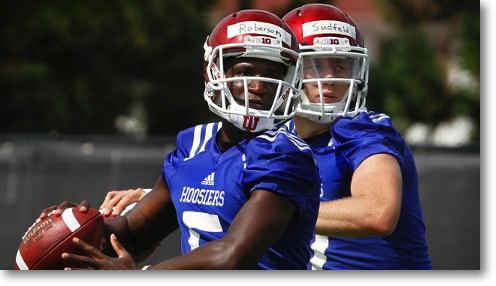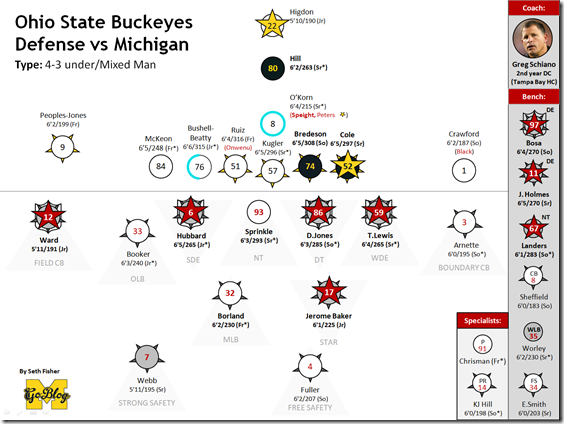in which I vaguely hope that the defense portion of FFFF matters one bit
[Author: sorry. Previously: Ohio State Offense]
You can’t take the sky from me.
Ohio State is everything wrong with America. While most hardworking football teams have to struggle day-in and day-out to make ends meet opposing quarterbacks, the Buckeyes have so much wealth they can leave most of it cooling on the sideline, chatting with the next wave of 5-stars and Bosas. They won’t even let any of it trickle out to the NFL or, like, Cincinnati. Three out of the seven hellbeasts they rotate through on the defensive line turned down this year’s NFL draft, and a fourth would be a top-five pick next April except he’s still too young to go.
With national economy-breaking riches up front, they can afford to play a ton of Cover 1 and Man 2 low—coverages that jam the middle of the field with fast players and take advantage of their natural athletic advantages over everyone they play on the outside. You can’t run on them or pass deep because of that line. You can’t spread ‘em out and throw short because they’re up in your grill and expecting it, and anyway you’re only getting to one read before a DE has turned the corner and your pocket’s bulged inward from a snap-jumpin’ Leviathan.
So how the hell did Iowa’s offense drop 38 points on these guys? For one they got to go a half and a drive with Bosa out for targeting. They also got a friendly flag. And their quarterback had an uncanny ability to shrug off tackles, going so far as to set up and throw a form TD pass with Sam Hubbard hanging on his leg the whole time. And most of all their offensive line held up in pass pro long enough for him to hit drags and comeback routes. None of this is relevant to Michigan starting John O’Korn and a right side of the line that couldn’t pass pro against Minnesota.
What is relevant is the week after Iowa, the Buckeyes held Brian Lewerke to an 11.5 QBR and 3 yards per dropback by accidentally fixing their one glaring defensive issue (they had a spacebacker playing middle linebacker). I watched both games, and while I’d love to tell you we’re too pretty to die on Saturday, the main takeaway here is Ohio State’s defense has it so Alabama-good these days they don’t even recognize how Alabama-despicable they’ve become.
-----------------------------------
Personnel: My diagram gets bigger with a click, and requires explanation:
Last year at this time I told you Ohio State’s defense this year was going to be a lot like Michigan’s defense last year. Had they not lost some guys early to the NFL that would be true. It’s still mostly true, especially up front; their second team front seven would probably be a Top 10 national front seven.
Part of that is they’re not starting their best front seven. DE Nick Bosa isn’t a “starter” in only the most technical sense—see: Mo Hurst last year—despite being their best player to PFF and the eye test. Backup NT Robert Landers, a scrappy-ass, undersized muck-a-muck, is again behind a more ballyhooed space-eater—this year it’s Godin-like Tracy Sprinkle instead of Michael Hill (who’s all but disappeared), but any crucial down will see Landers (#67) in, and for good reason. The other backup DE Jalyn Holmes came back for a fifth year despite plenty of NFL interest, and has barely any drop-off from last year’s B1G DL of the Year Tyquan Lewis.
The main weakness all season was they moved extraneous spacebacker Chris Worley to MLB, and he’s not one. With their two starting OLBs (Booker and Baker) missing time in the last few weeks, Ohio State moved Worley back to WLB and played MLB Tuf Borland, a 2016 high four-star who played for friend of the blog Todd Howard in high school. Worley is listed first in the “OR” and I imagine they’ll play him at WLB in their 4-4 look; Borland is the better fit.
Against MSU and Illinois they also played a freak athlete, true sophomore Malik Harrison, as their TE-destructor SAM spot. Harrison is now listed as a co-starter on OSU’s official depth chart, and I didn’t even have room for him on my diagram. The starters at OLB are Dante Booker and Jerome Baker. Both are Viper types; Booker would have been the starter last year but for an early season injury. Baker who’s about 20 pounds lighter, was a PFF fave-rave last year as a sophomore. Neither have any trouble keeping up with backs—Baker can “get skinny in the hole” as the coaches say, but he had some trouble with fullbacks in his first go-round.
The safeties are the weakest point. SS Damon Webb is a quasi-nickelback who’s solid at run fits but remains a liability in coverage. FS Jordan Fuller is not the superior athlete Malik Hooker was. They’ll sometimes replace him with Erick Smith, who’s more of a run-stopper. I imagine if Michigan’s going heavy Ohio State will prefer to remove one of these guys to get Booker, Baker, Worley, and Borland all on the field at once. CB Denzel Ward is one of the fastest players in OSU history—he got bodied by Simmie Cobbs in the opener and has been lights out since. The other corner spot rotates between Damon Arnette and JUCO transfer Kendall Sheffield, both of whom rely on elite athleticism, which for Big Ten passing games is plenty.
[Hit THE JUMP for the rest of the breakdown. Or don’t and go be with your family.]

Indiana's quarterback battle isn't quite over yet (photo via courier-journal.com)
Indiana fell back to earth after their program-first triumph over Penn State, allowing 473 yards in a 42-28 loss to Michigan State and pulling starting QB Nate Sudfeld in the fourth quarter after he struggled to move the ball. I've watched each of these games and think I have a grasp on Indiana's overall quality: a well-coached offense that can put up points on anyone but is limited by their talent in the backfield and on the line coupled with a defense that's ... well, pretty bad.
For an expansion on that boiled-down point, let's go to the full breakdown.
OFFENSE

WR Cody Latimer is off to the best start of his career (Andrew Weber/US Presswire)
Spread, Pro-Style, or Hybrid? Spread. The Hoosiers don't have a fullback, almost always have at least three receivers on the field, and never go under center, even in short-yardage situations.
Basketball on Grass or MANBALL? Basketball on grass. They didn't run much in this game, but when they did it was read option with QB Tre Roberson or simple inside zones.

99